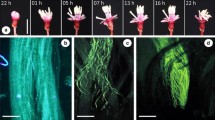Abstract
In hermaphrodite neotropicalLauraceae a highly evolved dichogamous system is present which represents a kind of temporal dioecy. This system involves the existence of two flower morphs which are characterized by reciprocal phases of receptivity of the stigmas and pollen release. In some genera (Persea, Cinnamomum), nectar is produced as a reward for the flower visitors, while in other genera (Aniba, Clinostemon, Licaria), nectar is absent and pollen seems to be the only reward. This implies that in this case the flowers in the female stage must be deceptive flowers. In dioecious species of the generaOcotea andNectandra, both the male and female flowers attract the visitors with nectar. The pollen-ovule ratio of theLauraceae is comparatively low. — The type of reproductive system that characterizes theLauraceae, comprising functional dioecy, small, inconspicuously coloured flowers, pollination by small bees, and large, one-seeded fruits dispersed by birds, is quite prominent among trees of various families in the tropical lowland forest. The relationship between the different modes of flowering within theLauraceae and the causes for the correlation of their reproductive traits are discussed.
Similar content being viewed by others
References
Arroyo, M. T. K., 1976: Geitonogamy in animal pollinated tropical angiosperms: a stimulus for the evolution of self-incompatibility. — Taxon25, 543–548.
Baker, H. G., 1959: Reproductive methods as factors in speciation in flowering plants. — Cold Spring Harbor Symp.24, 177–191.
Bawa, K. S., 1974: Breeding systems of tree species of a lowland tropical community. — Evolution28, 85–92.
—, 1979: Breeding systems of trees in a tropical wet forest. — New Zealand J. Bot.17, 521–524.
—, 1980: Evolution of dioecy in flowering plants. — Ann. Rev. Ecol. Syst.11, 15–39.
—, 1975: Dioecism in tropical forest trees. — Evolution29, 167–179.
Cope, F. W., 1962: The mechanism of pollen incompatibility inTheobroma cacao L. — Heredity17, 157–182.
Cruden, R. W., 1977: Pollen-ovule ratios: A conservative indicator of breeding systems in flowering plants. — Evolution31, 32–46.
—, 1979: Viscin threads, pollination efficiency and low pollen-ovule ratios. — Amer. J. Bot.66, 875–879.
Fedorov, A. A., 1966: The structure of the tropical rainforest and speciation in the humid tropics. — J. Ecol.54, 1–11.
Galil, J., Zeroni, M., 1967: On the pollination ofZizyphus spina-christi (L.)Willd. in Israel. — Israel J. Bot.16, 71–77.
Gentry, A. H., 1982: Patterns of neotropical plant species diversity. — InHecht, Wallace, Prance, (Eds.): Evolutionary Biology15, 1–83.
Givnish, T. J., 1980: Ecological constraints on the evolution of breeding systems in seed plants: Dioecy and dispersal in gymnosperms. — Evolution34, 959–972.
Gleeson, S. K., 1982: Heterodichogamy in walnuts: Inheritance and stable ratios. — Evolution36, 892–902.
Hesse, M., Kubitzki, K., 1983: The sporoderm ultrastructure inPersea, Nectandra, Gomortega and some other Lauralean genera. — Pl. Syst. Evol.141, 299–311.
Howe, H. F., Vande Kerckhove, G. A., 1981: Removal of wild nutmeg (Virola surinamensis) crops by birds. — Ecology62, 1093–1106.
Janzen, D. H., 1971: Seed predation by animals. — Ann. Rev. Ecol. Syst.2, 465–492.
Kostermans, A. J. G. H., 1957:Lauraceae. — Reinwardtia4, 193–256.
Kubitzki, K., 1981: The canaliculate exine ofLauraceae andHernandiaceae, a novel type of exine structure in Seed Plants. — Pl. Syst. Evol.138, 139–146.
—, 1982: Monograph ofAniba. — Flora Neotropica31, 1–84.
Kurz, H., 1982: Fortpflanzungsbiologie einiger Gattungen neotropischer Lauraceen und Revision der GattungLicaria. — Thesis, Faculty of Biology, University of Hamburg.
Lewis, D., 1979: Sexual Incompatibility in Plants. — London: E. Arnold.
Pohl, F., 1937: Die Pollenerzeugung der Windblütler. — Beih. Bot. Centralbl.56 A, 365–470.
Prance, G. T., (Ed.), 1982: Biological Diversification in the Tropics. — New York: Columbia Univ. Press.
Ridley, H. N., 1930: The Dispersal of Plants Throughout the World. — Ashford, Kent: Reeve.
Ruiz Zapata, T., Arroyo, M. T. K., 1978: Plant reproductive ecology of a secondary deciduous tropical forest in Venezuela. — Biotropica10, 221–230.
Sedgley, M., 1980: Anatomical investigation of abscissed Avocado flowers and fruitlets. — Ann. Bot.46, 771–777.
Skutch, A. F., 1932: Observations on the flower behavior of the Avocado in Panama. — Torreya32, 85–94.
—, 1945: The behavior of the flowers of the Aguatacillo (Persea caerulea). — Torreya45, 110–116.
Sobrevila, C., Arroyo, M. T. K., 1982: Breeding systems in a montane could forest in Venezuela. — Pl. Syst. Evol.140, 19–37.
Stout, A. B., 1927: The flower behaviour of Avocados. — Mem. N.Y. Bot. Gard.7, 145–203.
Author information
Authors and Affiliations
Rights and permissions
About this article
Cite this article
Kubitzki, K., Kurz, H. Synchronized dichogamy and dioecy in neotropicalLauraceae . Pl Syst Evol 147, 253–266 (1984). https://doi.org/10.1007/BF00989387
Received:
Accepted:
Issue Date:
DOI: https://doi.org/10.1007/BF00989387




